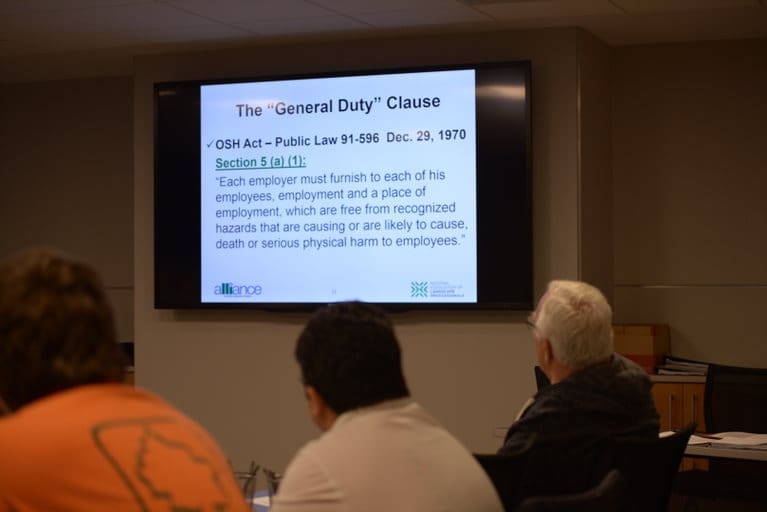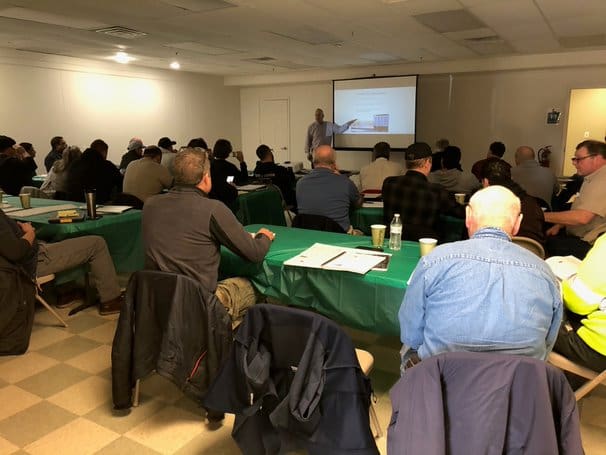
The landscape construction and lawn care industry has its fair share of risks when it comes to injuries and illnesses. Safety training helps build awareness to recognize and prevent hazards on the job site.
One form of safety training available for you and your crews is the OSHA 10-Hour Construction Safety Course for the Landscape Industry.
“We’ve customized the original OSHA models and that was all approved by the OSHA education center so now we’ve got a program that’s very customized to the hazards and risks that impact NALP member workers and employees,” says Sam Steel, NALP’s safety adviser.
Industry-Focused Course

Photo: NALP
This 10-hour course follows the construction industry OSHA standards but focuses on landscape-related topics such as the operation of zero-turn mowers, woodchippers and chainsaws. The program is designed to cater to the hazards that landscapers in different regions have to deal with.
“Our program is flexible enough to handle all the different regions that we have members in,” Steel says. “When we present it, we present it based on the season and we can adapt it to our members.”
Due to COVID-19, the course is currently offered online via Zoom. There is an upcoming course on Jan. 19-20, 2021, 10 a.m. to 4 p.m. ET.
With the online setup, Steel says they look at where most of the attendees are based to make sure they don’t use any hazard examples that are not relevant to their areas.
“The primary focus in our mission is to prevent injuries or illnesses that relate to the types of work that landscapers do,” Steel says.
Setting a Safety Baseline
The course includes an introduction to the OSHA standards, fall prevention, struck-by hazards, caught-in and between hazards, electrical hazards, chemicals in the workplace, personal protective equipment, power tools and equipment, health hazards in landscaping, excavation safety, material handling and miscellaneous safety hazards.
Steel says one of the top 10 cited hazards OSHA writes citations for involves flying debris. These have a first-time fine that is close to $14,000 per fine. He stresses that a whole list of citations and $40,000 or $50,000 in fines can easily ruin a small to medium-sized business.

Some of the health hazards Steel covers in the course are silicosis, which is caused by breathing in dust when cutting pavers and heat/cold exposure.
Steel says the OSHA 10-hour course serves as a nice base for safety training and should supplement your existing safety program.
“We don’t want the firms to use just this safety training alone,” Steel. “It’s the guidelines for all the safety training that you do and you want to make sure what you’re doing is successful.”
Benefits of Being OSHA Certified
Steel says companies should highlight the fact their staff has been OSHA 10 certified.
“I think that’s a good sales thing to use a promotion,” he says.

On the residential side, Steel says it’s on the companies to make sure their customers understand the importance of the OSHA training and how it exemplifies your commitment to safety. On the commercial side, many big general construction firms subcontracting the landscape work look for companies that are OSHA certified. Meanwhile, government jobs require companies to be OSHA certified.
Those who complete the course earn a 10-Hour Construction completion card and a certificate from NALP along with 10 Continuing Education Units (CEUs).
“The students who are trained and get certified in the full 10 hours, their cards are good for life,” Steel says. “There is no time limit on their card, but that doesn’t mean you stop training.”
Who Should Attend
As for who should attend this course, everyone from field employees to owners can benefit from attending.

“In an ideal world, for our members, it would really be nice if a cross-section of senior management to field supervisors or crew managers to human resources and right down the line, attended the course,” Steel says.
In one instance, the owner of a firm attended the training along with 41 employees and Steel said it had a big impact on the workforce seeing the owner there.
NALP offers private sessions for an entire company if they want to do it in one sitting.
Interested in attending an OSHA 10-Course? Click on the date to sign up for the Jan. 19-20 course.

